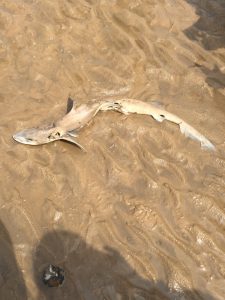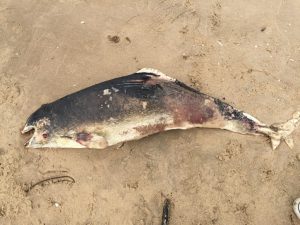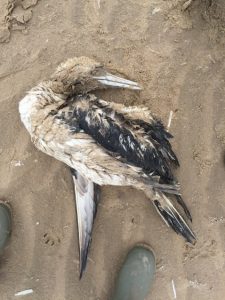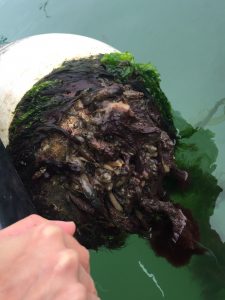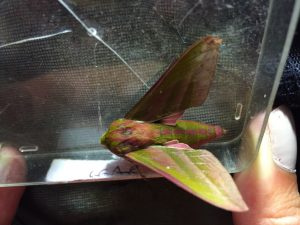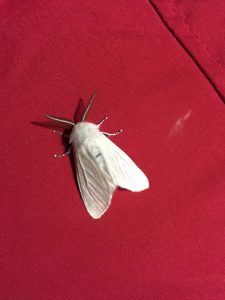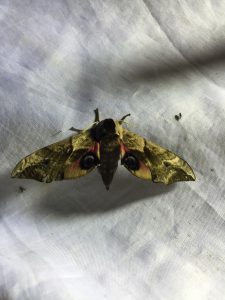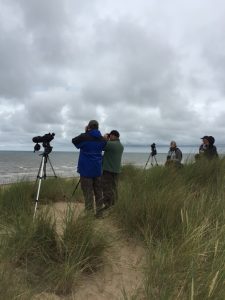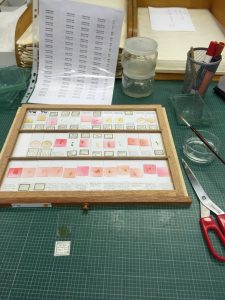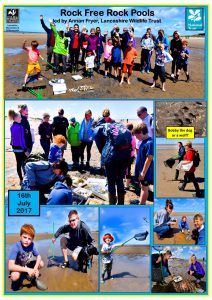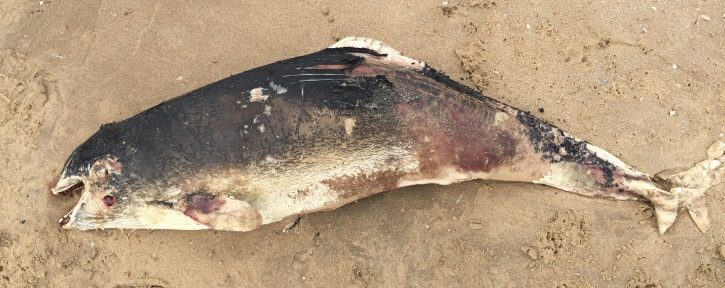
Shore surveys and Wednesday Waders
I am extremely lucky to be able to regularly walk the Sefton coastline and I am always amazed that you can find something different every time! Surveying the mudflats is something I could do all day, working with The Wildlife Trusts and the National Trust I get the opportunity to share my passion with the public. The ‘Wednesday Waders’ sessions ran by these organizations are a great way to meet the public and together walk along Formby beach. A session I ran by myself is the Rock Free Rock-pooling, aimed at getting younger generations excited about our coast.
Beached marine life can appear along our coast allowing you to see species up close that you perhaps wouldn’t usually.
Fleetwood marina
I recently attended a marine invasive species course in Fleetwood marina and the finds were incredible! The sea squirts and seaweeds created a whole ‘other worldly’ habitat. We identified several invasive species that will form the basis of a surveying project. This project will be a useful comparison to past research taken out by Natural England. Invasive species must be regularly monitored to control or try to prevent their spread.
Mothing
My first time mothing was extremely enjoyable and something I will definitely do again! We made base in the sand dunes off Ainsdale beach and found over 100 different species of moth through the night. We mainly used the simple (but very effective) method of a sheet and powerful bulb, then also had two moth traps out. Among my favourite were the Elephant Hawkmoth, White Satin Moth and the Eyed Hawk-moth.
Sea Watch
With the public and friends from Lancashire Wildlife Trust, I partook in a Sea Watch off the shore of Formby. We picked the tallest sand dune and at high tide climbed, equipped with binoculars and scopes. The recordings from sea watches like this are sent off to the Sea Watch Foundation, you can print off your own sheet and follow the key to input data! Although cetaceans were our biggest hope, we were lucky enough to see Grey Seals bobbing along in the waves. Many sea birds flew past and we enjoyed watching beautiful Gannets diving.
Curator work
Being lucky enough to have a base in Liverpool World Museum has given me the opportunity to experience first hand the roles of curators. I have begun pressing specimens I have collected, ready to then be mounted on herbarium sheets. I have learnt how to label specimens with accession numbers which then allows them to be added to Mimsy XG, an online database. I am currently working on the late George Russell’s’ collection. He dedicated many hours of his life to algae and has hundreds of samples collected from many English shores.
I have the chance to collect, process and store my own collection of mudflat specimens and I cannot wait!
Rock Free Rock-pooling
On Sunday 16th July I ran a rock pooling session alongside the National Trust at Formby. With no rocky habitat along our Sefton Coast, we used raised peat beds and explored the pools that form around them. Both children and adults dived right in, looking for all different species. We collected samples in trays, identified them, and then released any live specimens. Shells are great to identify and if empty can be kept, one lady enjoys making jewellery out of shells which is something I will definitely be trying!

